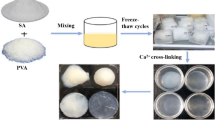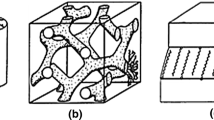Abstract
With the increasing interest in the development of new materials from bio-renewable resources seen in the last couple of decades, great emphasis has been put in the use of bio-renewable materials as building blocks for the preparation of bio-based polymers and composites. Lately, cardanol, a phenol derived from extracts of cashew nut shells, has gained attention due to its abundance, lack of competing applications, and great potential for the preparation of supramolecular structures through various routes. In this chapter, an initial overview of supramolecular gels is presented, covering background information on the terminology, chemical structure, properties, and the starting materials used in their synthesis. A section is dedicated to the latest advancements of cardanol-based gels, followed by a section describing applications involving cardanol-based gels and related self-assembled materials.
Access this chapter
Tax calculation will be finalised at checkout
Purchases are for personal use only
Similar content being viewed by others
References
Sangeetha NM, Maitra U (2005) Supramolecular gels: functions and uses. Chem Soc Rev 34:821–836. doi:10.1039/B417081B
Steed JW (2011) Supramolecular gel chemistry: developments over the last decade. Chem Commun 47:1379–1383. doi:10.1039/C0CC03293J
Yang X, Zhang G, Zhang D (2012) Stimuli responsive gels based on low molecular weight gelators. J Mater Chem 22:38–50. doi:10.1039/C1JM13205A
Lloyd GO, Steed JW (2009) Anion-tuning of supramolecular gel properties. Nat Chem 1:437–442. doi:10.1038/nchem.283
Kumar DK, Steed JW (2014) Supramolecular gel phase crystallization: orthogonal self-assembly under non-equilibrium conditions. Chem Soc Rev 43:2080–2088. doi:10.1039/C3CS60224A
Dastidar P (2008) Supramolecular gelling agents: Can they be designed? Chem Soc Rev 37:2699. doi:10.1039/b807346e
Steed JW (2010) Anion-tuned supramolecular gels: a natural evolution from urea supramolecular chemistry. Chem Soc Rev 39:3686. doi:10.1039/b926219a
Segarra-Maset MD, Nebot VJ, Miravet JF, Escuder B (2013) Control of molecular gelation by chemical stimuli. Chem Soc Rev 42:7086–7098. doi:10.1039/C2CS35436E
Buerkle LE, Rowan SJ (2012) Supramolecular gels formed from multi-component low molecular weight species. Chem Soc Rev 41:6089. doi:10.1039/c2cs35106d
Piepenbrock M-OM, Lloyd GO, Clarke N, Steed JW (2010) Metal- and anion-binding supramolecular gels. Chem Rev 110:1960–2004. doi:10.1021/cr9003067
Smith DK (2010) Supramolecular gels: Building bridges. Nat Chem 2:162–163. doi:10.1038/nchem.566
Yu G, Yan X, Han C, Huang F (2013) Characterization of supramolecular gels. Chem Soc Rev 42:6697–6722. doi:10.1039/C3CS60080G
Abdallah DJ, Weiss RG (2000) Organogels and low molecular mass organic gelators. Adv Mater 12:1237–1247. doi:10.1002/1521-4095(200009)12:17<1237:AID-ADMA1237>3.0.CO;2-B
John G, Vemula PK (2006) Design and development of soft nanomaterials from biobased amphiphiles. Soft Matter 2:909–914. doi:10.1039/B609422H
Weng W, Beck JB, Jamieson AM, Rowan SJ (2006) Understanding the mechanism of gelation and stimuli-responsive nature of a class of metallo-supramolecular gels. J Am Chem Soc 128:11663–11672. doi:10.1021/ja063408q
Beck JB, Rowan SJ (2003) Multistimuli, multiresponsive metallo-supramolecular polymers. J Am Chem Soc 125:13922–13923. doi:10.1021/ja038521k
Kotova O, Daly R, dos Santos CMG et al (2015) Cross-linking the fibers of supramolecular gels formed from a tripodal terpyridine derived ligand with d-block metal ions. Inorg Chem 54:7735–7741. doi:10.1021/acs.inorgchem.5b00626
Li X, Kuang Yi, Shi J et al (2011) Multifunctional, biocompatible supramolecular hydrogelators consist only of nucleobase, amino acid, and glycoside. J Am Chem Soc 133:17513–17518. doi:10.1021/ja208456k
Suzuki M, Hanabusa K (2009) l-Lysine-based low-molecular-weight gelators. Chem Soc Rev 38:967–975. doi:10.1039/B816192E
van Bommel KJC, van der Pol C, Muizebelt I et al (2004) Responsive cyclohexane-based low-molecular-weight hydrogelators with modular architecture. Angew Chem Int Ed 43:1663–1667. doi:10.1002/anie.200352396
Boekhoven J, Poolman JM, Maity C et al (2013) Catalytic control over supramolecular gel formation. Nat Chem 5:433–437. doi:10.1038/nchem.1617
Placin F, Desvergne J-P, Lassègues J-C (2001) Organogel electrolytes based on a low molecular weight gelator: 2,3-bis(n-decyloxy)anthracene. Chem Mater 13:117–121. doi:10.1021/cm001118h
Hanabusa K, Hiratsuka K, Kimura M, Shirai H (1999) Easy preparation and useful character of organogel electrolytes based on low molecular weight gelator. Chem Mater 11:649–655. doi:10.1021/cm980528r
Hirst AR, Coates IA, Boucheteau TR et al (2008) Low-molecular-weight gelators: elucidating the principles of gelation based on gelator solubility and a cooperative self-assembly model. J Am Chem Soc 130:9113–9121. doi:10.1021/ja801804c
Rajaganesh R, Gopal A, Mohan Das T, Ajayaghosh A (2012) Synthesis and properties of amphiphilic photoresponsive gelators for aromatic solvents. Org Lett 14:748–751. doi:10.1021/ol203294v
Vemula PK, John G (2008) Crops: a green approach toward self-assembled soft materials. Acc Chem Res 41:769–782. doi:10.1021/ar7002682
Balachandran VS, Jadhav SR, Vemula PK, John G (2012) Recent advances in cardanol chemistry in a nutshell: from a nut to nanomaterials. Chem Soc Rev 42:427–438. doi:10.1039/C2CS35344J
Voirin C, Caillol S, Sadavarte NV et al (2014) Functionalization of cardanol: towards biobased polymers and additives. Polym Chem 5:3142–3162. doi:10.1039/C3PY01194A
John G, Masuda M, Okada Y et al (2001) Nanotube formation from renewable resources via coiled nanofibers. Adv Mater 13:715–718
John G, Jung JH, Masuda M, Shimizu T (2004) Unsaturation effect on gelation behavior of aryl glycolipids. Langmuir 20:2060–2065. doi:10.1021/la030177h
John G, Minamikawa H, Masuda M, Shimizu T (2003) Liquid crystalline cardanyl β-d-glucopyranosides. Liq Cryst 30:747–749. doi:10.1080/0267829021000047516
Anilkumar P, Jayakannan M (2010) A novel supramolecular organogel nanotubular template approach for conducting nanomaterials. J Phys Chem B 114:728–736. doi:10.1021/jp909016r
Anilkumar P, Jayakannan M (2006) New renewable resource amphiphilic molecular design for size-controlled and highly ordered polyaniline nanofibers. Langmuir 22:5952–5957. doi:10.1021/la060173n
Antony MJ, Jayakannan M (2009) Self-assembled anionic micellar template for polypyrrole, polyaniline, and their random copolymer nanomaterials. J Polym Sci Part B Polym Phys 47:830–846. doi:10.1002/polb.21689
Anilkumar P, Jayakannan M (2007) Single-molecular-system-based selective micellar templates for polyaniline nanomaterials: control of shape, size, solid state ordering, and expanded chain to coillike conformation. Macromolecules 40:7311–7319. doi:10.1021/ma071292s
Lalitha K, Jenifer P, Prasad YS et al (2014) A self-assembled π-conjugated system as an anti-proliferative agent in prostate cancer cells and a probe for intra-cellular imaging. RSC Adv 4:48433–48437. doi:10.1039/C4RA07710E
Mahata D, Mandal SM, Bharti R et al (2014) Self-assembled cardanol azo derivatives as antifungal agent with chitin-binding ability. Int J Biol Macromol 69:5–11. doi:10.1016/j.ijbiomac.2014.05.017
Teerasripreecha D, Phuwapraisirisan P, Puthong S et al (2012) In vitro antiproliferative/cytotoxic activity on cancer cell lines of a cardanol and a cardol enriched from Thai Apis mellifera propolis. BMC Complement Altern Med 12:27. doi:10.1186/1472-6882-12-27
De Maria P, Filippone P, Fontana A et al (2005) Cardanol as a replacement for cholesterol into the lipid bilayer of POPC liposomes. Colloids Surf B Biointerfaces 40:11–18. doi:10.1016/j.colsurfb.2004.09.007
John G, Jung JH, Minamikawa H et al (2002) Morphological control of helical solid bilayers in high-axial-ratio nanostructures through binary self-assembly. Chem Eur J 8:5494–5500. doi:10.1002/1521-3765(20021202)8:23<5494:AID-CHEM5494>3.0.CO;2-P
Silverman JR, Samateh M, John G (2015) Functional self-assembled lipidic systems derived from renewable resources. Eur J Lipid Sci Technol 118:47–55. doi:10.1002/ejlt.201500198
Bhavsar GA, Asha SK (2011) Pentadecyl phenol- and cardanol-functionalized fluorescent, room-temperature liquid-crystalline perylene bisimides: effect of pendant chain unsaturation on self-assembly. Chem Eur J 17:12646–12658. doi:10.1002/chem.201101011
Anilkumar P, Jayakannan M (2007) Fluorescent tagged probing agent and structure-directing amphiphilic molecular design for polyaniline nanomaterials via self-assembly process. J Phys Chem C 111:3591–3600. doi:10.1021/jp066428n
Author information
Authors and Affiliations
Corresponding author
Editor information
Editors and Affiliations
Rights and permissions
Copyright information
© 2017 Springer International Publishing AG
About this chapter
Cite this chapter
Garrison, T.F., Scholz, A., Grimm, H., Quirino, R.L. (2017). Cardanol-Based Supramolecular Gels. In: Anilkumar, P. (eds) Cashew Nut Shell Liquid. Springer, Cham. https://doi.org/10.1007/978-3-319-47455-7_7
Download citation
DOI: https://doi.org/10.1007/978-3-319-47455-7_7
Published:
Publisher Name: Springer, Cham
Print ISBN: 978-3-319-47454-0
Online ISBN: 978-3-319-47455-7
eBook Packages: Chemistry and Materials ScienceChemistry and Material Science (R0)




